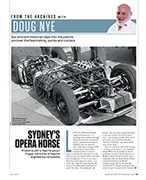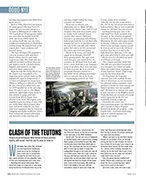

From the archives with... Doug Nye
Sydney's opera horse Problems with a 4wd Ferguson trigger memories of bygone engineering complexity Late on the Saturday night at Goodwood’s ‘72’ meeting, I was walking through the paddock when…

Phil Hill on the Le Mans pitwall in 1957: engine failure meant he never got to race in that year's event, but the disappointment two years later was more intense
Klemantaski Collection/Getty Images
For Phil Hill there is absolutely no doubt about the win that got away from him: Le Mans, 1959, when victory slipped from his grasp with a little over four hours remaining.
“It was the one race in my career that I really remember should have been ours, and wasn’t,” he says. “That disappointment really pointed out the injustices of motor-racing.”
The race should have provided a repeat victory for Phil and co-driver Olivier Gendebien, who had won the rain-hit 1958 event at the wheel of a works Ferrari 250TR. Although they were very different personalities, the American and Belgian forged a successful partnership over the years.

Gendebien (left) and Hill were Le Mans winners in 1958
Getty Images
“We drove together in 1956 in Argentina and finished second, and it was then that we found out that we had similar approaches; we both had a sort of feeling for not busting up the machinery. Everybody says, ‘Today, it’s real racing, and in those days, it was just a cruise’. But that’s a lot of crap!
“Olivier wasn’t really that mechanically knowledgeable, but any time that it was necessary to understand a certain mechanical concept, he had no problem at all. For example, we started out with a big handicap at Le Mans in 1958. A right-front brake was picking up the lining on the drum, and we spent hours getting rid of that condition until we could use the brakes properly — and eventually we won.”
The triumphant pair were reunited at La Sarthe in 1959. They had won Sebring that year, with Chuck Daigh and Dan Gurney, and just a fortnight before Le Mans, had finished a close second at the Nürburgring to the Aston Martin of Stirling Moss and Jack Fairman.
“That was a huge lesson for me – never try and outguess Dame Fate”
Ferrari had three works entries on hand for the 24-hour marathon, the other machines crewed by Gurney/Jean Behra and Cliff Allison/Hermano da Silva Ramos. Their most serious opposition came from the trio of Aston Martin DBR1s handled by Moss/Fairman, Roy Salvadori/Carroll Shelby and Maurice Trintignant/Paul Frère.
Aston Martin had formulated a clear strategy that involved Moss acting as a hare, and the other two green cars adopting different degrees of caution. Ferrari, by contrast, had no formal plan, although Hill and Gendebien certainly had no intention of getting strung along by Moss: “Our car was terrific, and we let the other guys knock themselves out”
Stirling duly set a hard early pace, and Behra stayed with him. After a chaotic first set of pitstops by the Italian team, Gurney got ahead of Fairman, but it was another Ferrari which failed first, Allison suffering gearbox problems that led to a broken engine. Not long after that, Moss retired the pace-setting Aston after broken pieces of air intake were sucked into a cylinder.

Gendebian was at the wheel with a four-lap advantage when Le Mans’ capricious fate struck
Klemantaski Collection/Getty Images
Hill/Gendebien dropped back with carburation problems, and Behra/Gurney established a firm lead until they, too, suffered an engine failure. The calculated approach of the Shelby/Salvadori Aston now paid dividends as it took the lead. But they weren’t the only ones who had preserved their equipment, and after the Aston had a long stop for new pads, Hill/Gendebien sailed into the lead.
They stayed there throughout the night and into the morning, opening up a four-lap advantage on the Aston. But it all started to go wrong when the Belgian was at the wheel.
Hill recalls: “I got up at around 11 am – the Shell place served as sleeping quarters and I started walking back to the pits. All of a sudden I heard, ‘The lead car is in the pits unexpectedly!’ We ran down there and discovered that Olivier was out of water. He hadn’t noticed the problem until the needle was off the dial. And he still had a certain number of laps to go before he was allowed to top up.”
In those days, teams had to run 30-lap stints between fluid replenishments, and without even the chance to check the level in the sealed radiator, there was little that the team could do.
What happened next was described in that August’s edition of Motor Sport by Denis Jenkinson:
The mechanics increased the fuel pump pressure in the vain hope that the trouble was being caused by weak mixture in the hot morning sunshine.
One lap later the car was back and a check was made on the oil level, and water was poured onto the fuel pump in the hope that vapour locks were causing the weakness to the carburation and the consequent overheating.’
Gendebien managed to complete a few more laps, but it was a hopeless task, and the car was retired at 11.45am, before the engine was completely destroyed. Hill was absolutely devastated.
“In retrospect, I remembered the mechanics pouring some stuff in in the middle of the night, but they were always putting little tinctures of one sort or another in there.
“One of those little copper rings that seals the individual combustion chambers had been giving a bit of trouble and had finally burned through. I wish we’d been allowed to know that. I don’t know if we would have been able to do anything or not, but if we had any idea what cylinder it might have been, perhaps we could have taken the plug out and struggled on with 11 cylinders – and still won.
“That was a huge lesson for me – never try and outguess Dame Fate. The whole race was so easy, and we were playing it so cool, and we were fresh off our ’58 win. That was the first time I ever really counted the money. We were ahead on Index as well as overall, and we were going to get equal money for both things. Down the straight, I was counting it all!
“It was an enormous disappointment. We could not believe that it had been snatched away from us.”

Salvadori/Shelby Aston Martin DBR1 takes victory after the Ferrari failure
The record books show only that Salvadori and Shelby scored the biggest win of their careers.
“Oh God, we have to keep reminding them how far back they were! We were four laps ahead.”
Gendebien and Hill were supposed to share at Le Mans in 1960, too, but they were split up. The Belgian won with countryman Paul Frère, while Phil and Wolfgang von Trips stopped early when they ran out of fuel! But the story has a happy ending: Phil and Olivier went on to win together in ’61 and ’62. Three in five years is not a bad record. But it could have been even better.